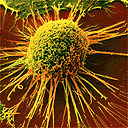
Surgery on tumours could become easier and more effective thanks to a "paint" derived from scorpion venom.
The glowing paint can help doctors distinguish between cancerous and healthy tissue, even if the tumour is made up of only a few hundred cells.
The paint is made from a protein in scorpion venom called chlorotoxin, which can bind to cancer cells.
By joining chlorotoxin with a fluorescent marker called Cy5.5, a team of researchers from Seattle children's hospital created a way to make tumours stand out against a background of healthy cells.
"My greatest hope is that tumour paint will fundamentally improve cancer therapy," said James Olson, who led the research. "By allowing surgeons to see cancer that would be undetectable by other means, we can give our patients better outcomes."
Surgery is still the main treatment for tumours. Despite advances in technology, surgeons often have to rely on colour, texture or blood supply to tell cancers apart from healthy tissue.
The technique has limitations that can contribute to later regrowth of cancers. In surgery for brain tumours, for example, 80% of malignant cancers return at the edges of the original site of the cancer because a few cancerous cells are left behind after surgery.
MRI scanners can distinguish tumours from healthy tissue, but only if more than 1m cancer cells are present. In contrast, the chlorotoxin method was able to identify tumours in mice with as few as 2,000 cells.
The chlorotoxin paint would not only reveal whether surgeons had left behind any bits of a tumour, but would also help them to avoid removing normal tissue.
Dr Olson described his chlorotoxin experiments yesterday in the journal Cancer Research.
Before the chlorotoxin paint is available for use in humans, it will need to go through several more stages of clinical trials to ensure that it is not toxic.
If it passes these tests - and researchers are confident that trials could be completed within 18 months - Dr Olson said the paint could also be used in future as a non-invasive way to screen for a range of cancers including skin, cervical, colon, gut, lung, breast, prostate and testicular cancer.

